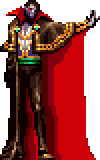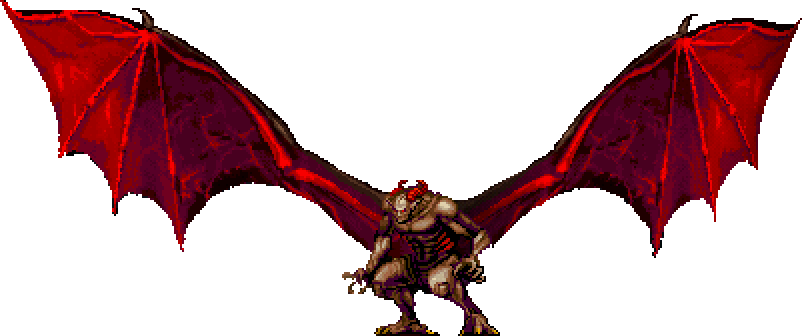| . |
Castlevania:
Portrait of Ruin
|
. |
  |
Ol' Drac is back for his second encounter with a Morris family member, but his typical "first form" hasn't readied many new tricks. The teleporting wonder this time alternates between two separate release attacks: Fireballs, which he fires in three waves--three-directional then five-directional then again three; and four pulsating orbs, which are fired in succession high, low, high and low. The very real danger (and a first for this series) is the battle's circumstance: Dracula has a tag-team partner in the form of Death, with whom he fights right alongside in honor of the game's running theme. Dracula peppers in his teleport attacks while Death muddles up the area with its scythe strikes; otherwise, Death will assist with team assaults, which include Dracula's bat-company dash, a scythe wave plus pulsating-orb storm, and an atomic explosion. As both share the same energy, you can focus a counterattack on either.

In clear danger of failing his mission, Death offers up his soul, which Dracula readily steals and uses as the catalyst for his transformation into True Dracula, a second form typical of recent games. The winged Count uses its room-filling size for a handful of devastating attacks that include a long-distance dash, a sudden ground-pound that causes damaging debris to fly forward, and the release of three large round flame-scythes. Additionally, Dracula can command a series of deadly missiles to rain down, each missile parallel to others which it accompanies, and leave the heroes precious little space to find safety as he continues to use his size to force collisions. When in trouble, Dracula will begin unleashing an attack that sees his claws quadruple in size and begin closing in on the heroes from either side; only by locating and striking the currently vulnerable finger, one after another, can the heroes thwart the attack, which if not met will close in and kill them in one shot.
 |
|
 |
||
| Next Form |
|
[Home] [What's New?] [CV Library] [Stages] [Reviews] [Weapons] [Castleography] [Multimedia] [Codes] [Links] |
||||